Arts & Entertainment Community
Day Tripper | A spooky stop on our Puget Sound Loop
I admit it. I’m easily distracted. Staying focused is not my strong suit.
Take last year, when I set out on a daytrip to Port Townsend to check out the place that’s reported to be one of the most haunted towns in the Pacific Northwest, if not the entire United States. Instead, I ended up in Port Gamble. There was so much about that unique little community that intrigued me that I never made it any further.
Last spring, I started what will eventually be a three-part series: The Puget Sound Loop. My first destination was Mukilteo. I have been thinking ever since about doing a late September story on Port Townsend. It seemed only appropriate to visit when paranormal activity would be at its most active.
Port Townsend purports to have more than a dozen places where the dearly departed are still hanging around, periodically making their presence known. What better way to get ready for the Halloween season than to check them out? This time I made it all the way there.
And, sometime in the next few months, I promise I will complete the loop by making the trek across the south end of Whidbey Island, traveling from Clinton to Coupeville.
Getting there
Port Townsend is approximately 69 miles from Gig Harbor. Just head north on Highway 16 until you have no choice but to merge onto Highway 3 at Gorst. Stay on Highway 3 north past Silverdale. Continue until you arrive at the Hood Canal floating bridge, Highway 104. Turn left to cross the bridge and continue to Highway 19 North. Merge onto 19 and continue until you arrive in Port Townsend.
That was a problem. After I crossed the bridge, I kept seeing places I wanted to check out. I could just see a repeat of the Port Gamble diversion happening all over again. I mustered up all the willpower I could find and told myself that once I’d checked out everything I was planning to see in Port Townsend, I could stop at as many places as I could fit in on my way home. Spoiler alert: there is so much to see and do in PT and at nearby Fort Worden that I didn’t have time to make any of those stops. I guess I need to plan on exploring more of that area sometime next year.
Port Townsend background
Port Townsend is in Jefferson County on the tip of the Quimper Peninsula, which is part of the greater Olympic Peninsula. The community is rich in history and full of Victorian architecture with two National Historic Landmark Districts. Captain George Vancouver named the bay Port Townshend in 1792 after his friend the Marquis of Townshend.
Port Townsend was Washington’s first major port and a boomtown in the mid-1800s. The S’Klallam Indians previously settled in the area, calling their community Kah Tai. As more European settlers arrived, hostilities ensued. Murder and mayhem were part of life in what was a frightening and dangerous place. Ladies of the evening were prevalent, leading to debauchery and violence. Romances commonly ended in heartbreak when men sailed out to sea, never to return, or died as a result of the dangers of their work. Parapsychologists say there’s little wonder that so many spirits are still hanging around.
Fort Worden, located on the outskirts of town, is reputed to be among the most haunted former military bases in the country. Overlooking the Salish Sea, the Army built the fort in the early 1900s to protect access to the Puget Sound.
Spirited-filled hotels
In an attempt to stay focused on the primary purpose for this expedition, I decided I would check out a few of the locations that give Port Townsend its ghastly ghostly reputation. People have reported paranormal activity in more than 25 buildings. I decided to choose a few of the most well-known. My first stop was Manresa Castle.
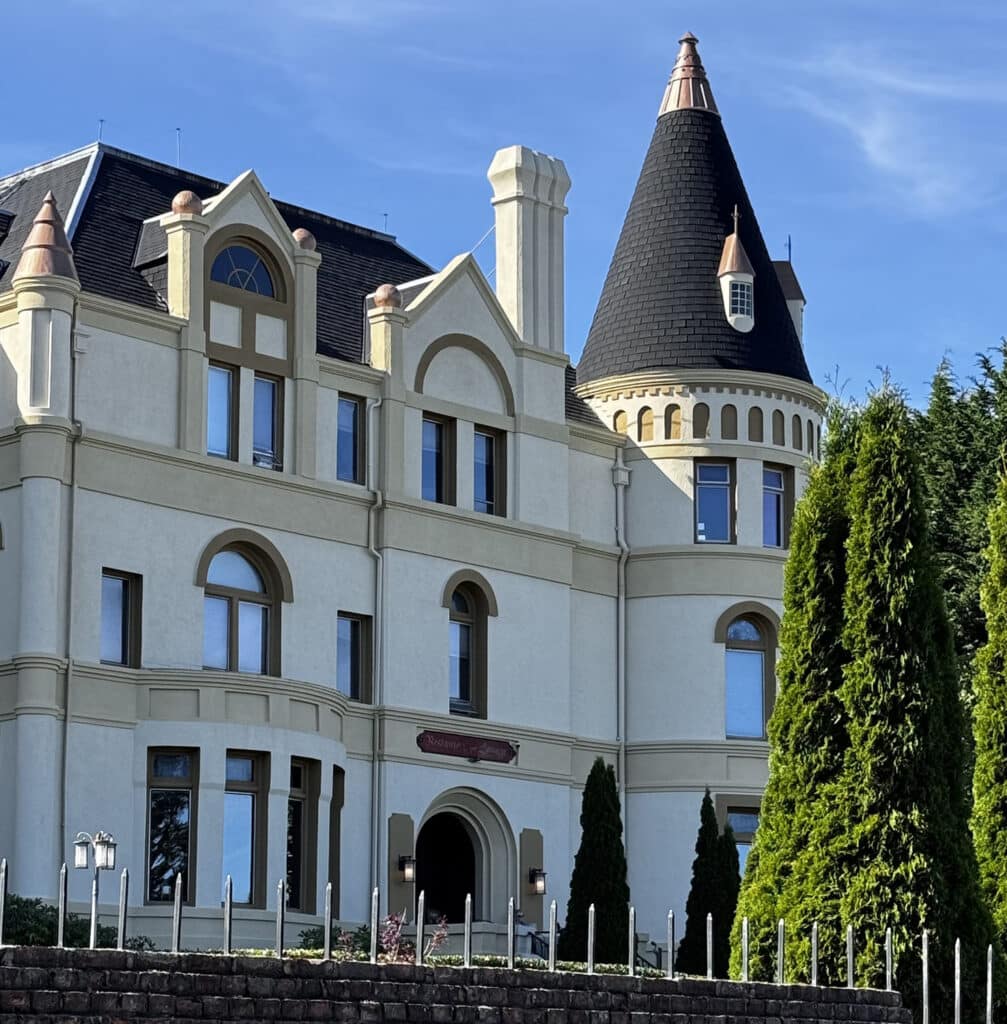
Manresa Castle in Port Townsend. Photo by Mary Williams
As you approach the downtown waterfront, make the Manresa Castle Hotel at 651 Cleveland St. your first stop.
Charles and Kate Eisenbeis built it in 1892 as their home. Eisenbeis, a prominent businessman, was the city’s first mayor. The home contained 30 rooms and had 12-inch-thick brick walls and a slate roof. Rooms contained tiled fireplaces and finely crafted woodwork.
The castle sat empty for almost 20 years after Charles died in 1902. A Seattle attorney bought it in 1925. Later, Jesuit priests purchased the building and used it as a training facility for 16 years. They added a large wing with a chapel and sleeping rooms, as well as an elevator. They named the building Manresa Hall after the Spanish town where Ignatius Loyola founded their order.
The building has had three owners since 1968, and all have worked to both maintain its Victorian elegance and renovate it to meet current needs. In 1968 the huge structure contained only 3 bathrooms. Today it has 43. The building is on the National Register of Historic Places.
Rooms 302 and 306
Apparently spirits like it, too. Rooms 302 and 306 reportedly have the highest rate of paranormal activity.
Legend has it that a young woman named Kate threw herself from the window of Room 306 after learning of her lover’s death. Lights flicker and the TV turns on and off without human help. There is also a strong odor of old-fashioned perfume that suddenly appears without warning, which some take as a sign she’s around.
The spirit of a monk lurks in room 302. He hanged himself in the bell tower. Guests in other rooms have reported hearing footsteps in the attic when no one is there. In the dining room, don’t be surprised if a drinking glass flies across the room and shatters or table settings unexpectedly turn upside down or dump on the floor.
I guess some people are eager to stay in Rooms 302 and/or 306, but I am not one of them. I was more than content to visit the hotel and look around but will encourage you to do your own reconnaissance when it comes to spirit hunting.
Holly Hill House
Holly Hill House at 611 Polk St. is a private residence. Well, it’s private if the owners don’t count a few resident ghosts. It is reported that some of the multiple spirits who live here also died here.
One of them was previous owner Robert Hill, who refuses to vacate the upstairs bedroom. Apparently not concerned with warnings from the Surgeon General, he regularly smokes cigars, allowing the smoke to waft from his room and through the hallways. The spirit of William Hill, Robert’s brother, also frequently visits the location of his death, the parlor. Despite the absence of a piano in the home, piano music plays when he’s in residence.
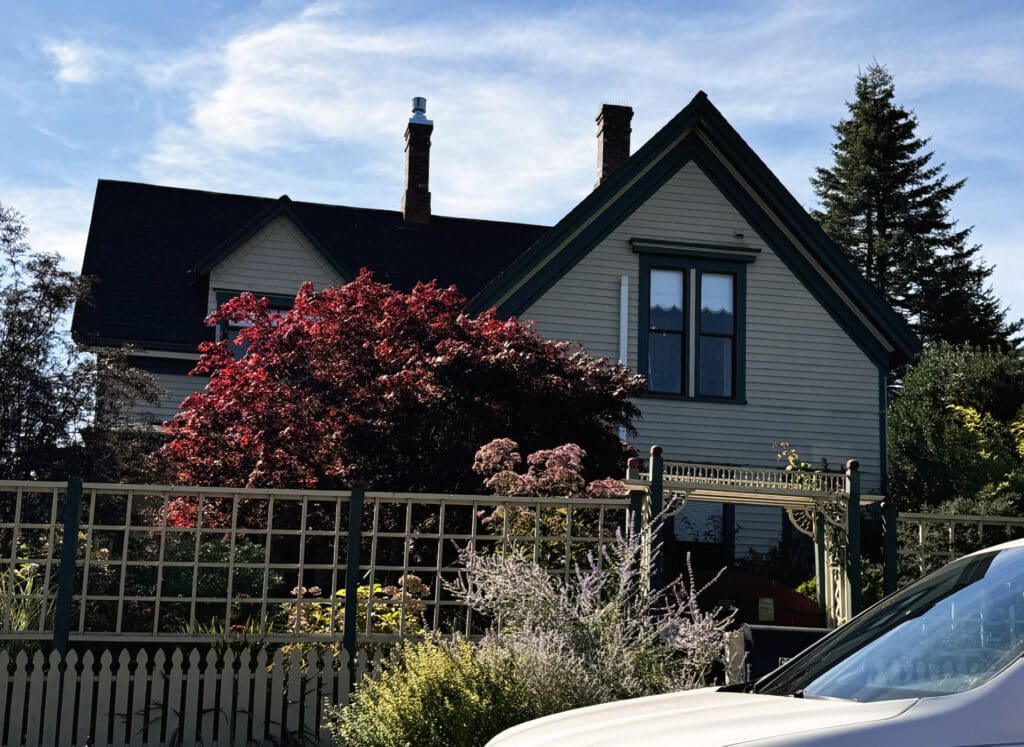
Holly Hill House in Port Townsend. Photo by Mary Williams
Palace Hotel
I stumbled across the Palace Hotel quite by accident. It was a Saturday afternoon, and the town was humming with activity, making finding a parking place a challenge. I spotted one, managed to parallel park, and prepared to begin my exploration. When I looked up, I was directly in front of the Palace Hotel at 1004 Water St.
Apparently, the Palace was originally a brothel. At least 10 spirits reportedly visit regularly or reside there, presumably ladies of the evening who met an untimely end.
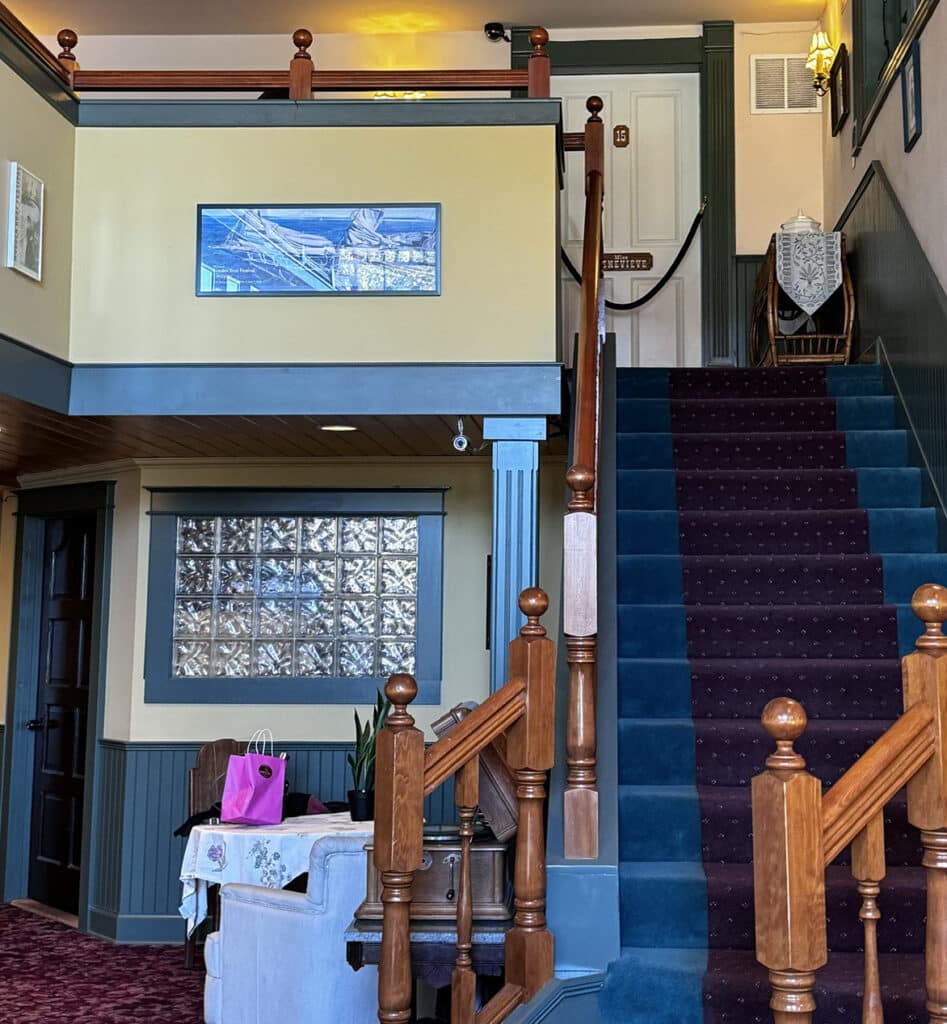
The Palace Hotel in Port Townsend, a former brothel. Photo by Mary Williams
Ann Starrett House B&B
The Starrett home, built in 1889, is at 744 Clay St. It is not Victorian, but rather was built in the Gothic & Stick architectural style. A significant feature of the house is a free-floating spiral grand staircase that terminates at a fresco painted on the ceiling of a 70’ tower. Only one other staircase of its age and kind still exists in the country.
George, Anne, their child Edwin, his nanny and two servants lived there for more than 20 years. They may still pay an occasional visit. Everything I’ve read about this home makes me think it’s a warm and gentle place. My next visit to PT may need to include an overnight there.
The best way to learn more about the haunts of Port Townsend is to go for a walk on a Saturday afternoon in October. The PT Main Street Program sponsors a series of walks and tours that will provide an opportunity for you to learn more about the community and potentially meet up with a spirit or two. You’ll hear stories about Port Townsend’s haunted past and present. The tours happen from 2 to 3:30 p.m. Oct. 12, 19 and 26. Only a handful of tickets, which cost $25, remain available for each date. so if you’re interested, don’t hesitate to get yours now.
Or, if you’re more interested in touring a vintage Victorian building, you can choose the Historic Hastings Building tour at 11 a.m. Oct. 26. The descendants of Lucinda Hastings maintain ownership of the building and are providing the tour. The building has not been renovated, has been vacant for 70 years, and has steep steps so this tour is not for the faint of heart. Tickets for the tour are $30 and can be purchased at the same website.
The Victorians
If you’re more interested in Port Townsend’s storied Victorian architecture than you are in its long-dead residents, there’s much to be seen and learned. Port Townsend is one of only three Victorian seaports in America recognized by the National Register of Historic Places as a Landmark Historic District.
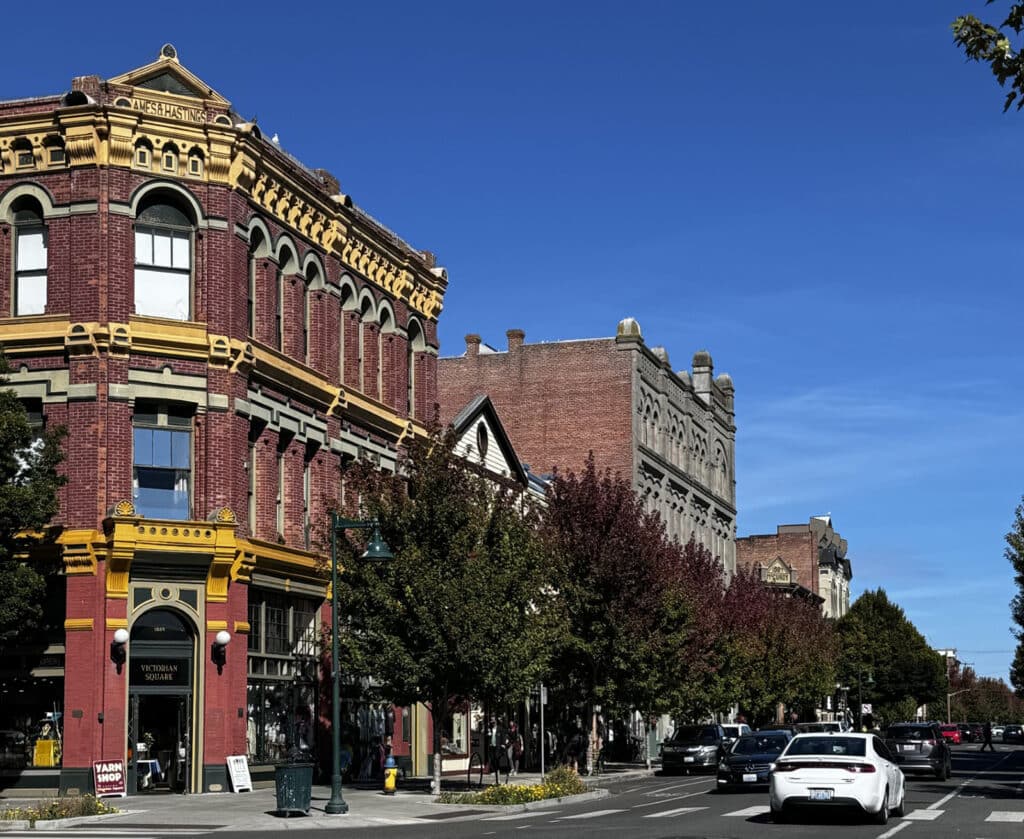
Victorian-style buildings in downtown Port Townsend. Photo by Mary Williams
The Jefferson County Courthouse, 1820 Jefferson St., was built in 1892 and listed on the National Register of Historic Places in 1973. It is still in use today. Designed by architect W. A. Ritchie, it has a 143-foot-tall tower and a working clock that strikes on the half-hour and hour.
The Victorians are celebrated annually at a Victorian Heritage Festival, which was founded in 1996 to celebrate the history and lifestyle of early life in Port Townsend. The next one is tentatively scheduled for April 25 through 27.
The Victorian Era meets 2024
Not everything in Port Townsend is about ghosts and Victorian architectural history. There is much to do and see in PT that is very much 21st century.
Creative District
In 2020, Port Townsend was officially designated a Creative District by the Washington State Arts Commission. The district sponsors an art walk from 5 to 8 p.m. on the first Saturday of each month. The mission of the district is to expand living-wage opportunities for artists who work, live, and show within the District by providing resources and support to market their craft. Check out their website to learn more about them and the artistic experiences they offer.
Marine Science Center
Given its proximity to the sea, it’s not surprising that ocean ecology and marine life is a major focus of the community. The Marine Science Center has several locations downtown and two others at Fort Worden.
I was lucky enough to find myself parked right in front of the historic Flagship Landing building at 1001 Water St. (we already know that’s right across the street from the Palace Hotel) which is home to the MSC Store and Gallery. The store includes a broad selection of books, puzzles, gear and supplies. Every member of the family can find a treasure here, but it seemed to me that it has an abundance of things for kids. (A little holiday shopping, anyone?) An exhibit informs visitors of the relationship between the Salish Sea, the Coast Salish People, and collaborations to restore and conserve the local watershed.
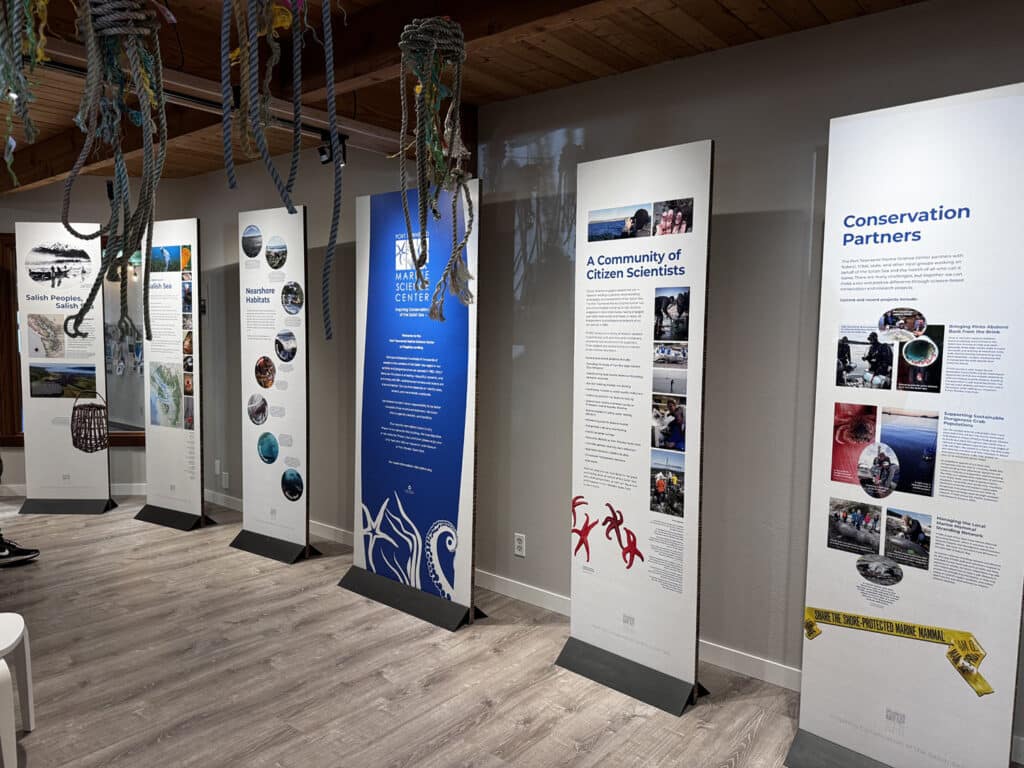
Inside the Marine Science Center in Port Townsend. Photo by Mary Williams
The gallery is in the same building. For the next couple of weeks, the primary exhibit is “ORCA: Shared Waters, Shared Home.” This interactive exhibit explores the natural history of the orca and the challenges they face in the Puget Sound. The exhibit is open from noon to 3 p.m. Friday through Sunday through Oct. 13. Admission is free.
Just down the street from the Flagship Landing building at the end of Taylor Street is the skeleton of Gunther, a 42-foot gray whale. A great deal of signage explains how Gunther ended up suspended at Union Wharf. The day I visited him, Gunther had crystal clear skies and a panoramic view of both the Salish Sea and the city.
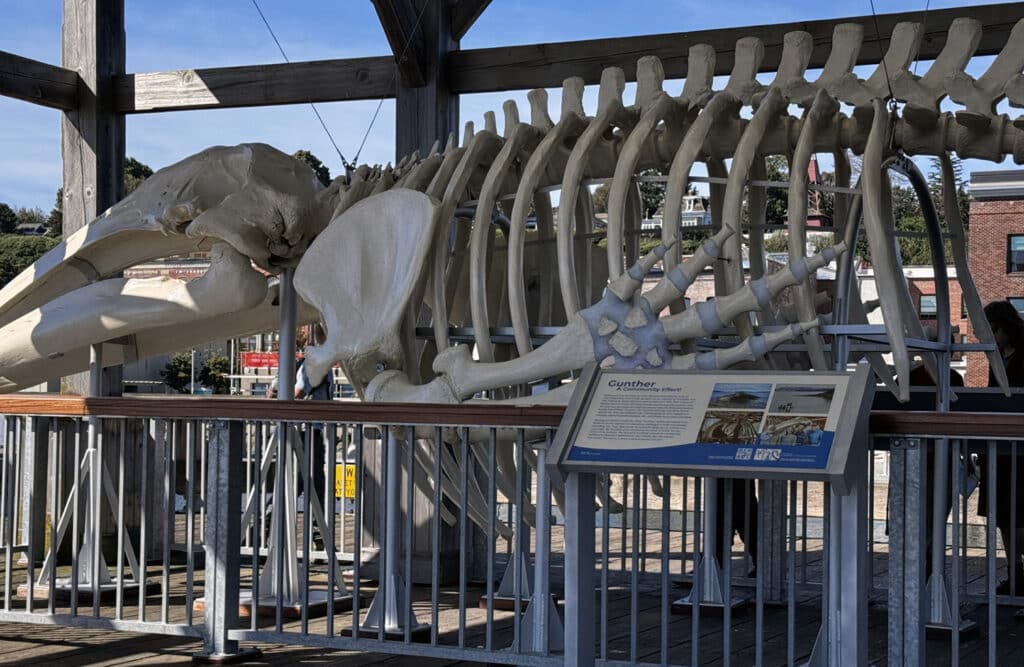
Gunther’s final resting place along the Port Townsend waterfront. Photo by Mary Williams
More Marine Science Center
The MSC’s second location is at Fort Worden. Exhibits at the aquarium feature local fish and invertebrate species and their habitats. The museum houses interactive displays and videos that explore the Salish Sea ecosystem, while the gift shop includes ornaments, locally sourced gifts, jewelry, books, and gear. The museum and gift shop are located across from the beach and pier. The aquarium is on the pier. Admission costs $7 for adults, $5 for kids ages 6 to 17, or free for kids 5 and younger. Hours are noon to 5 p.m. Friday through Sunday.
Fort Worden State Park
I thought I would have enough time to visit Fort Worden and investigate several of the most noteworthy landmarks there. I was wrong. There is too much to learn about the history of the fort, the organizations that now make their home there such as Centrum (which is celebrating its 50th anniversary this year), and many things to see like the Artillery Museum and Artillery Hill. I’m not sure when it will happen, but I know I need to make another day trip that focuses on the fort. I suspect I’ll be going when the Rhododendron Garden is in bloom. That should be worth seeing all by itself; right now it’s just a big, green, leafy field.
There are a couple of areas I’d like to share with you now because I found them to be particularly interesting and I had already checked them out before I decided the day was running out and I needed to abort the mission and head home.
I know I said we were done with ghosts, goblins and spirit life in general. I lied. Any discussion of Fort Worden must acknowledge its significance to the paranormal community. It’s considered one of the most haunted places in Washington and may be the most haunted former military encampment in the country.
Hikers and campers report hearing moans coming from the hallways of abandoned barracks. The first verified reports of spirits at Fort Worden surfaced after the park opened in August 1973. Many of the houses along Pershing Avenue have resident spirits from the base days, including the Commanding Officer’s Quarters. Others report the smell of burning coal, burning rubber, or hot sulfur just inside the front door. A well-known photo shows what many believe to be a spirit in purple clothing with his face reflected in a mirror.
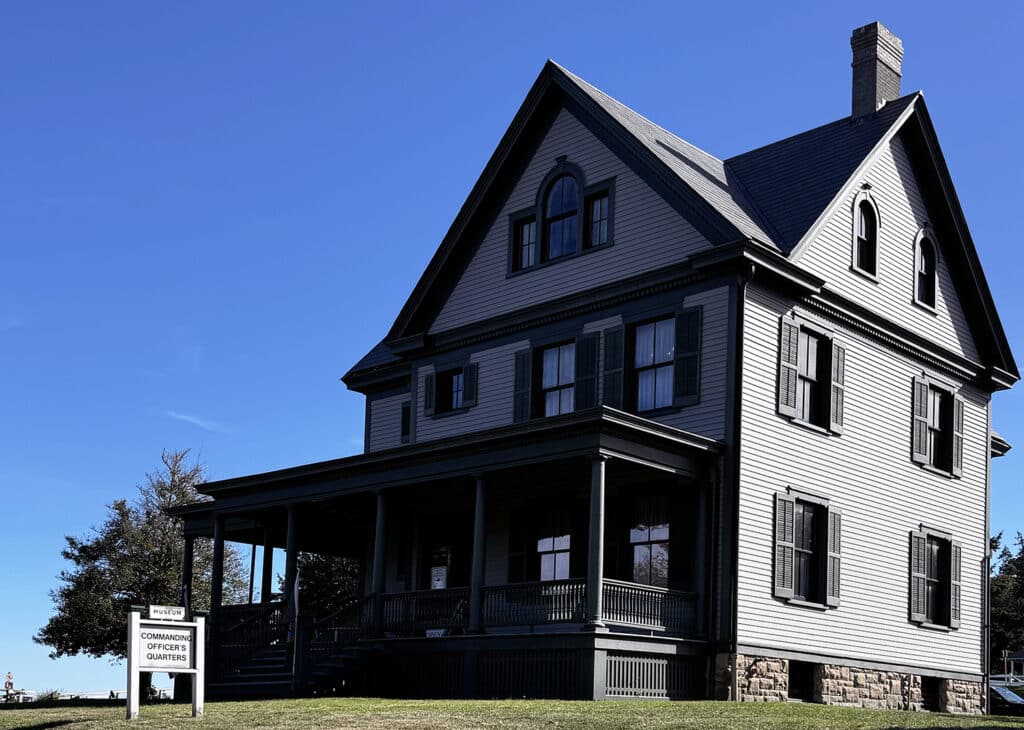
The purportedly haunted Commanding Officer’s Quarters at Fort Worden in Port Townsend. Photo by Mary Williams
Point Wilson Lighthouse
Point Wilson Lighthouse is at the northern end of Fort Worden at 200 Battery Way E. Built by the U.S. Coast Guard in December 1879, the light was originally atop the Keeper’s House. The Coast Guard built a new tower in 1913 and relocated the light.
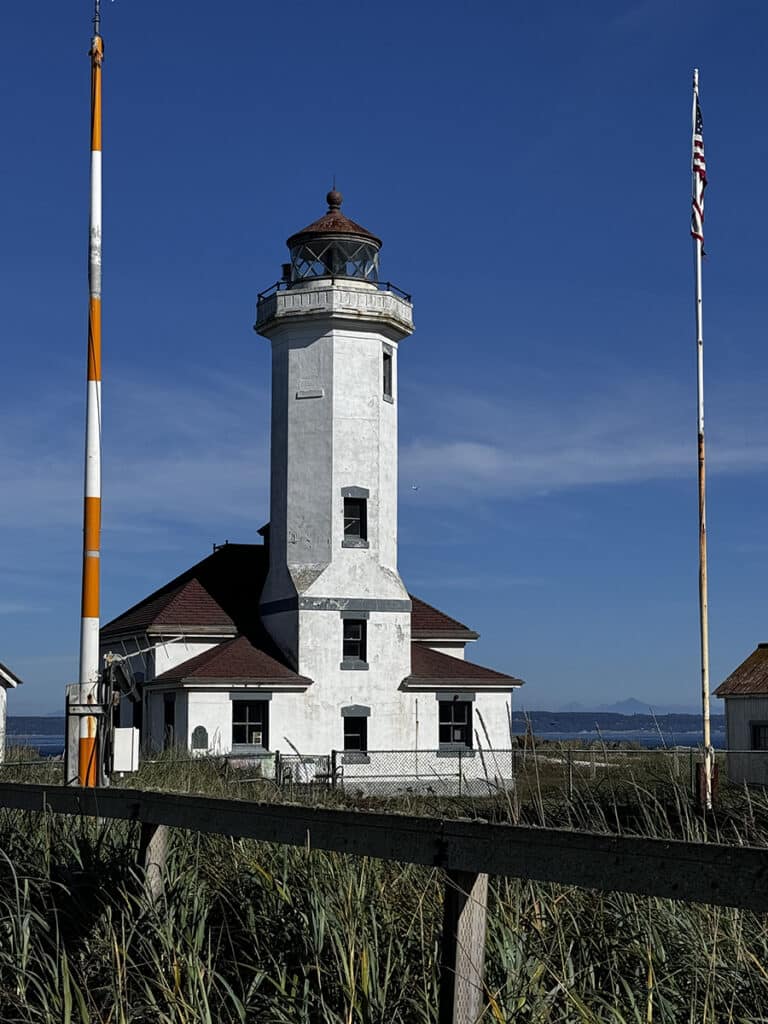
Point Wilson Lighthouse in Port Townsend. Photo by Mary Williams
It is the tallest lighthouse in Puget Sound and marks the spot where the Straits of Juan de Fuca meet up with the entrance to Admiralty Inlet and the Puget Sound.
Point Wilson Lighthouse is one of several in the system that can be rented. The Chief’s House, built in 1962, is available with a 2-night minimum stay. It formerly housed active-duty Coast Guard personnel on the local patrol boat.
Tours are available from 11 a.m. to 4 p.m. Saturdays and Sundays, May through September. Off-season tours can be arranged.
An extensive restoration project has been underway since 2019, when the Coast Guard issued a license to the nonprofit U.S. Lighthouse Society. They also provide tours to the public and run museum style interpretive displays. According to their website approximately $100,000 has been spent on infrastructure upgrades.
North Beach
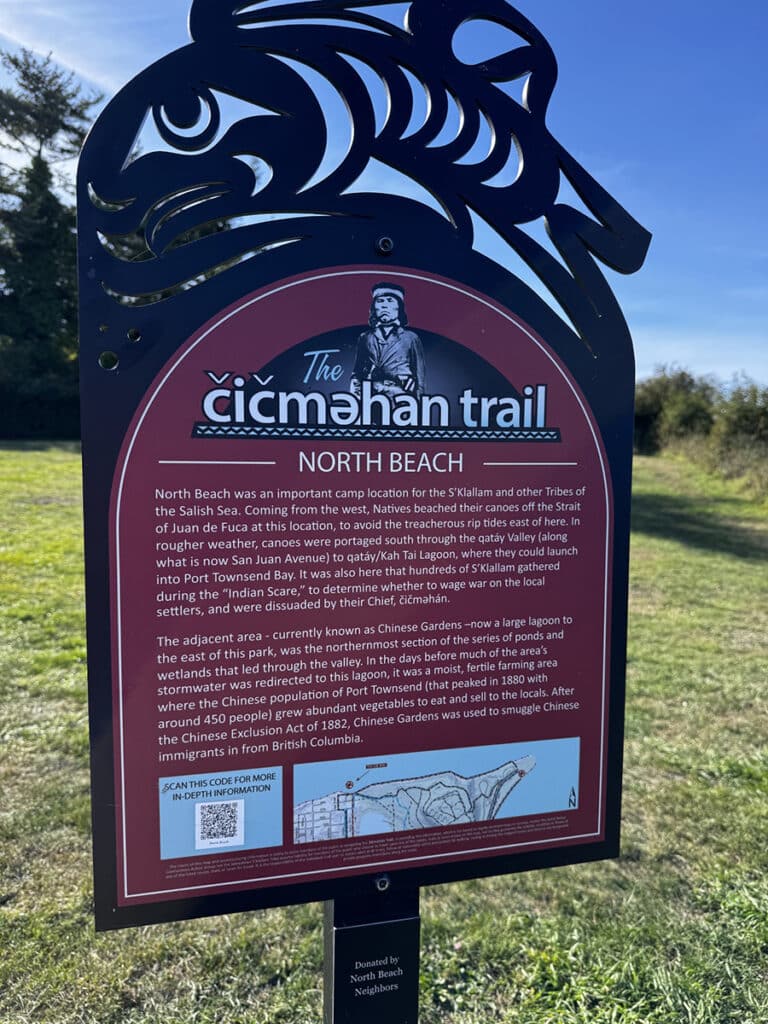
Eighteen signs like the one above are scattered around Port Townsend. They divide the area into 3-mile, 6-mile, or 12-mile loops. The shorter loops focus on downtown historical sites, while the longer loops extend west to Laurel Grove Cemetery or from North Beach and Fort Worden through the downtown area. A map of the trails is available here.
Jefferson County Parks and Recreation operates North Beach County Park. It is a small, day use park in a residential area with a small parking lot. Its primary claim to fame is that it is the starting location for the trail that leads to Glass Beach, a renowned area perfect for hunting for beach glass.
That’s not an easy task to undertake, and my only participation was to gaze down the beach wishing I’d visited 20 years ago when a 5-to-6-mile round trip hike through heavy sand wasn’t an impossibility.
Glass Beach
Anyone stressed about the environment will be horrified to learn how Glass Beach was created. Glass Beach was once a city dump. The sea has worked for decades trying to break down the trash that humans spent many years deliberately dumping on its shores. Garbage trucks would back up to the edge of the cliffs above the beach and dump their contents onto the sand and into the water below. The glass included soft drink and beer bottles, medicine containers, marbles, pottery, and porcelain. That practice ended in the 1960s. Over time, waves broke the glass into smaller pieces. Rocks and sand tumbled them until they were smooth, frosted sea glass in an array of vibrant colors.
Once you’ve parked in the North Beach parking lot at the end of Kuhn Street, follow the beach west. Towering bluffs edge a narrow three-mile stretch of shoreline. Before you reach the beach, you’ll see old rusting remnants from the former dump. Once you round McCurdy Point, you’ll see the long stretch of sandy waterfront that is Glass Beach. Let your treasure hunt begin, but don’t lose track of time.
Signs everywhere and every post online provide a warning about monitoring the tides. The beach is accessible at low tide. At high tide, water covers the beach. Hikers occasionally get stuck and have to climb to safety to wait it out (a LONG wait). If you don’t time it right, at the very least, you’ll end up wet and/or covered in seaweed. And I know you don’t want to be on the list of those who’ve not planned well and had to be plucked from the area by U.S. Coast Guard. Happy hunting!
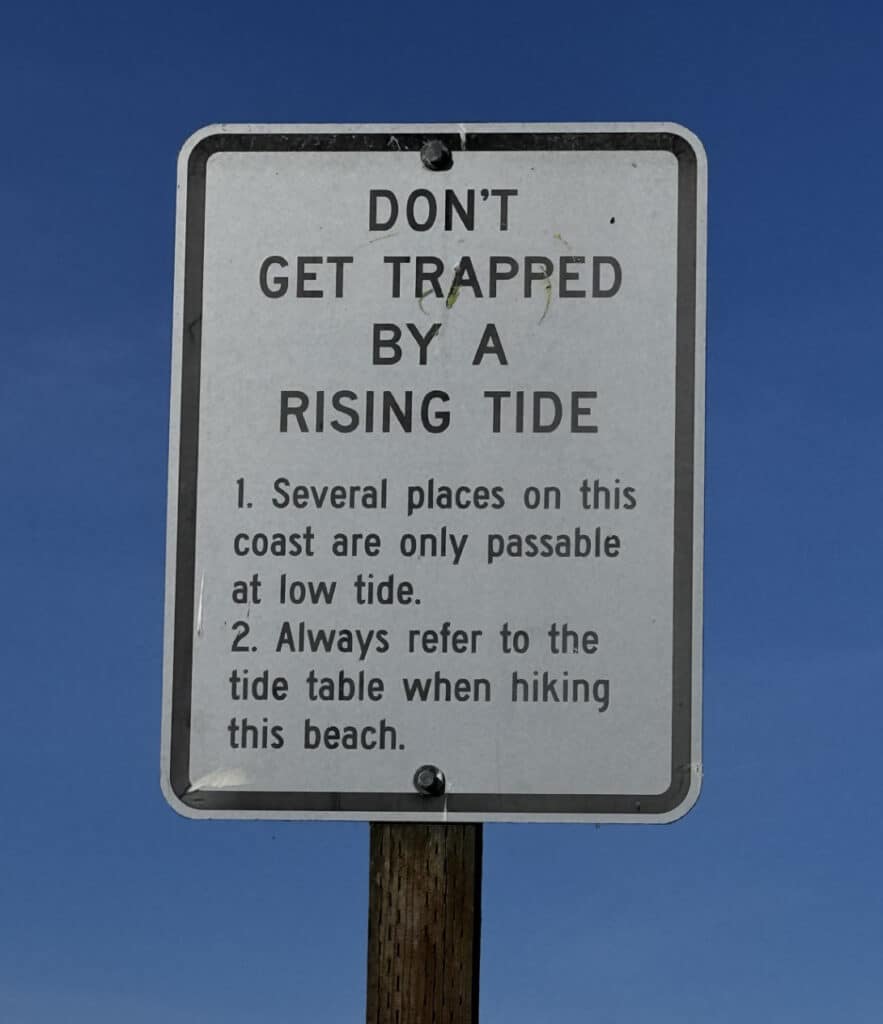
Pay attention to these signs.
About the Day Tripper column
Gas prices are sky high, and a night in a hotel is approaching astronomically expensive. So, for the foreseeable future, I imagine many of you are going to find yourselves taking day trips rather than the road trip vacations we’ve grown to love.
This beautiful region in which we live is ripe with opportunities to explore new places, see new things, and learn a little something at the same time. I promise to keep the longest journeys to a one-way distance of under 200 miles. Whether you want to make it an overnight trip, a weekend, or just a very long day trip, we should be able to pull it off.
I hope you’ll grant me the honor of your virtual company as we travel these roads together. Happy trails!
